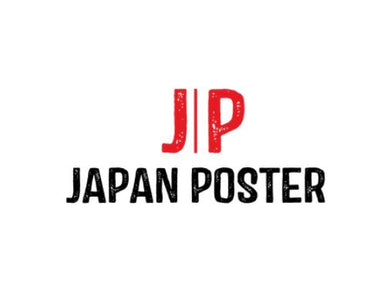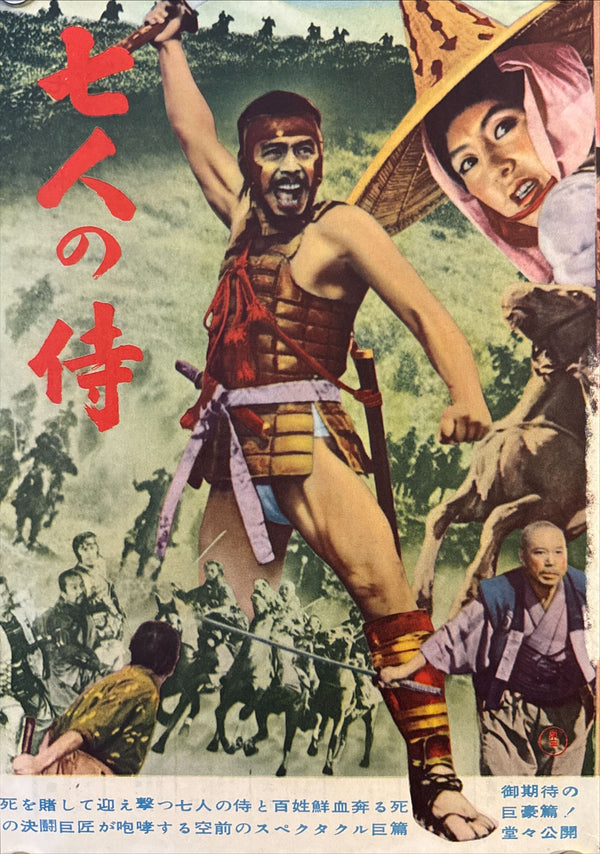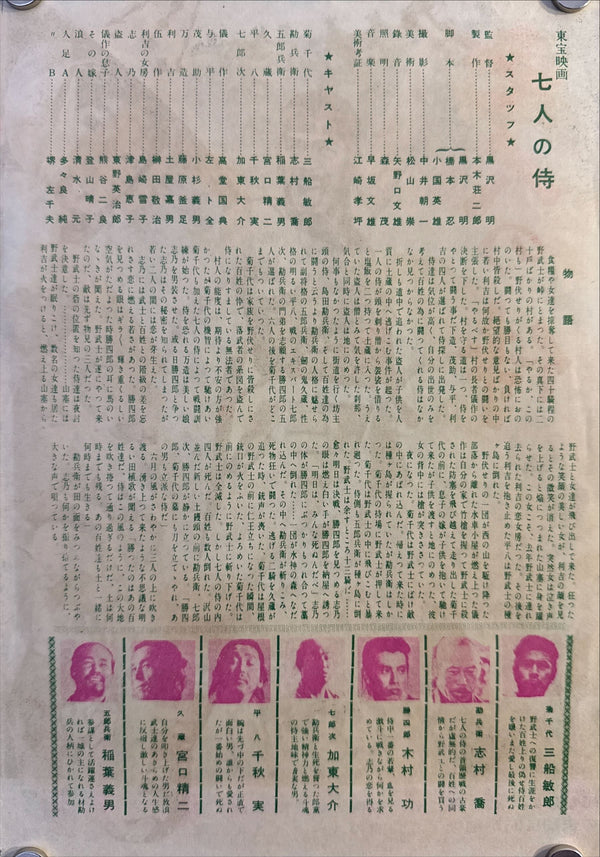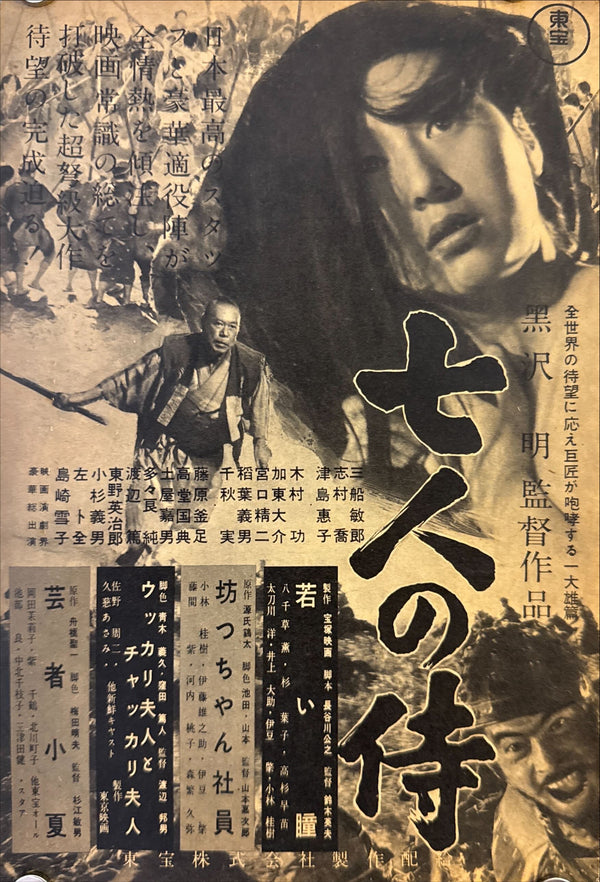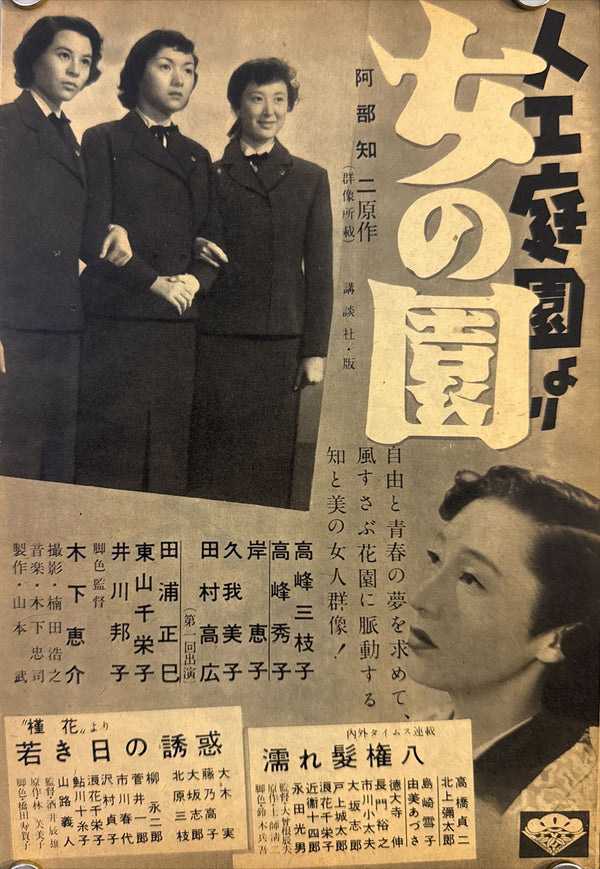
“Seven Samurai” (七人の侍) — Framed pair of original Japanese first‑release flyers for Kurosawa’s 1954 epic — Piece sizes c. 25.7 × 17.7 cm (smaller sepia) & 26 × 18.4 cm (larger color) • Overall framed size c. 31 × 44 cm
“Seven Samurai” (七人の侍) — Framed pair of original Japanese first‑release flyers for Kurosawa’s 1954 epic — Piece sizes c. 25.7 × 17.7 cm (smaller sepia) & 26 × 18.4 cm (larger color) • Overall framed size c. 31 × 44 cm
Pair of original Japanese B5‑type flyers for the first 1954 Toho release of Akira Kurosawa’s monumental jidai‑geki epic Seven Samurai, in both early monochrome and later full‑color designs.
Both sheets have now been professionally mounted together in a modern black frame with an off‑white mount and UV‑protective acrylic glazing (lighter and safer than glass). Sold framed as shown—a ready‑to‑hang, gift‑worthy display.
Size (unframed paper, approx.):
• Smaller sepia flyer (black‑and‑white): c. 25.7 × 17.7 cm (approx. 10.12 × 6.97 in)
• Larger color flyer: c. 26 × 18.4 cm (approx. 10.24 × 7.24 in, B5‑type)
• Issued for Toho Co., Ltd., Japan
Why this matters
Seven Samurai is one of the central works of world cinema—an ensemble heroic saga that redefined action filmmaking and inspired countless remakes, from The Magnificent Seven to A Bug’s Life. First‑release Japanese paper is the most resonant way to connect to that original cultural moment. Having both a heavy, sepia‑toned battle montage and a vivid color “spectacle” layout offers a mini‑survey of how Toho sold its most ambitious production of the 1950s, now unified in a single framed presentation.
About this piece
Format: two original double‑sided flyers (chirashi) from the 1954 Toho release, now double‑mounted in one frame.
• Piece A – Smaller sepia flyer (black‑and‑white): monochrome/sepia litho on thin stock. Front dedicated to Seven Samurai; the reverse advertises the women’s‑school drama Onna no Sono (女の園) along with additional Toho features.
• Piece B – Larger color flyer: rich full‑color front image for Seven Samurai; verso printed in green with detailed story synopsis, cast & staff credits, and small portrait vignettes of the seven samurai.
Design & iconography
The sepia sheet is dominated on the right by a brooding close‑up of Toshiro Mifune as the wild ronin Kikuchiyo, his hair whipping across his face. Below and to the left, Takashi Shimura’s Kambei leads a rush of peasants and samurai into battle; dust and spears fill the lower half of the page. The huge brush‑script title 「七人の侍」 drops vertically through the image. Blocks of credits along the bottom edge list the star‑studded cast and production staff, framed by small panels for other Toho releases, reminding viewers of the studio’s packed program.
The color flyer explodes the same energy into full chroma: Kikuchiyo, bare‑legged in lamellar armor, charges forward brandishing his sword, mouth wide in a defiant yell. A charging horse rears on the right, while at the horizon line a silhouetted line of mounted bandits gallops across the ridge. The red title letters blaze down the left margin, cutting through a wash of green fields and dust clouds. At the foot of the design, tiny battle scenes and key character portraits give a sense of the film’s scale. The green‑printed verso reads almost like a program book, with dense vertical text recounting the story and seven magenta portrait heads arranged in a row at the bottom.
Translations of the main captions
Main title: 「七人の侍」 — “Seven Samurai.”
Sepia flyer tagline:
「日本最高のスタッフと豪華適役陣が全情熱を傾けて打ち出した超娯楽大作」
— “Japan’s finest staff and a superb cast pour all their passion into this super‑entertainment epic.”
Color flyer tagline (top band):
「死を賭して迎え撃つ七人の侍と百姓、血煙る壮絶な決戦巨篇」
— “Seven samurai and the peasants stake their lives in a blood‑mist, all‑or‑nothing battle epic.”
Reverse‑side companion feature: 「女の園」 — Onna no Sono (“Garden of Women”), a Toho drama about a women’s school.
Rarity & significance
Authentic first‑release Toho flyers for Seven Samurai are among the most desirable of all Japanese cinema paper. Many examples were discarded after the initial run; surviving matched pairs that show both the gritty monochrome and the explosive color treatment are far less common. Professionally framed together, these two flyers chart the film’s journey from prestige production to pop‑culture spectacle and provide superb wall presence.
Condition
Very good for age. Both sheets show soft overall toning and light handling creases consistent with mid‑1950s newsprint‑weight paper. Corners lightly bumped with a few tiny edge nicks; no significant tears or losses to image areas. The color flyer retains strong saturation; text on both versos is clear and legible.
Both flyers are now professionally mounted in a modern black frame with off‑white mat and UV‑protective acrylic glazing. Frame and mount are clean and ready to hang. Please review the photos—these are the exact pieces offered.
Details
-
Country: Japan
-
Year of issue: 1954 (first Japanese release)
-
Sizes (unframed paper, approx.):
-
Smaller sepia flyer: c. 25.7 × 17.7 cm (approx. 10.12 × 6.97 in)
-
Larger color flyer: c. 26 × 18.4 cm (approx. 10.24 × 7.24 in, B5‑type)
-
-
Framed size: c. 31 × 44 cm overall
-
Printing: Original mid‑1950s printings; not reproductions
-
Versos: Sepia flyer reverse promotes Onna no Sono and other Toho features; color flyer reverse carries full synopsis, credits, and portraits of the seven samurai
-
Glazing: UV‑protective acrylic (not glass)
-
Authentication: COA included
